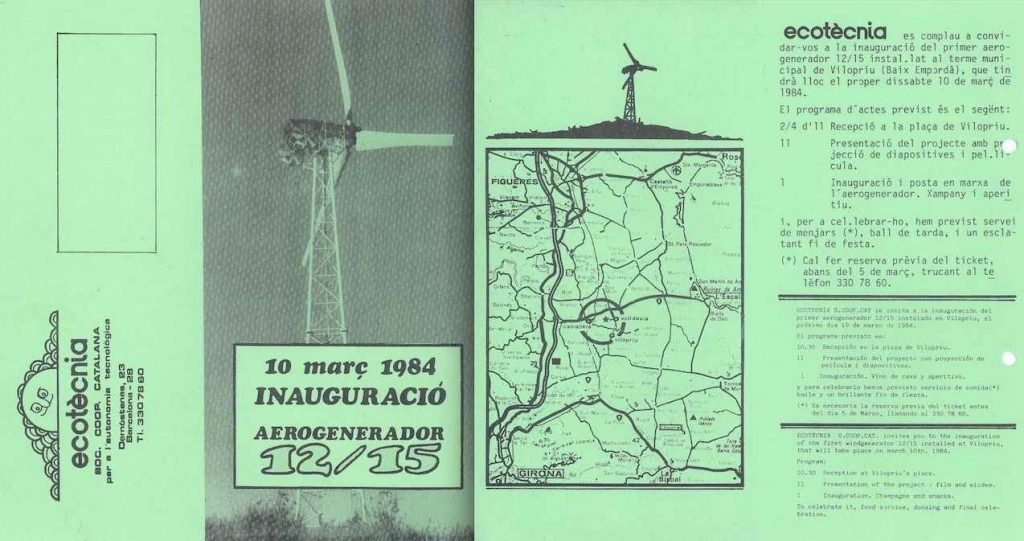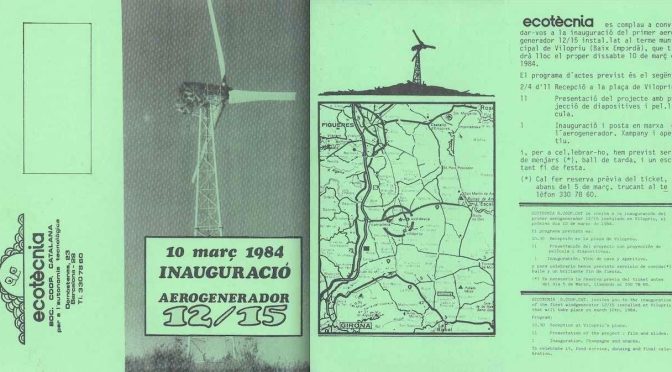The history of wind energy is fascinating, and I’ve always believed that it’s particularly poorly documented, especially in the case of Spanish wind energy. It’s a real shame that in a pioneering country and in a sector with only 40-50 years of history (at least what we call modern wind energy), many of the significant milestones and events have been forgotten.
For example, recently marked the 40th anniversary of the installation of the first Ecotècnia wind turbine, one of the pioneering manufacturers nationally. This wind turbine was the cornerstone of a company that made its mark in the wind energy sector.
This wind turbine has often been mistakenly labeled as the first in Spain (I myself did so back in 2016), but it actually has the honor of being the first prototype of Ecotècnia manufacturer and the first wind turbine connected to the grid in Catalonia. We’ll talk about the first wind turbine in Spain on another occasion, so subscribe if you don’t want to miss it.
But there are still some romantics out there. Thanks to Pep Puig, one of the key figures in the conception and implementation of that wind turbine, we’ve been able to recover some data and some spectacular and endearing images from that time. It’s been through a thread on Twitter/X that Pep has given me permission to adapt and bring to Windletter.
40 years since the commissioning of the Ecotècnia 12/15
On March 10th, 40 years ago, the Ecotècnia 12/15 wind turbine was commissioned. A wind turbine that marked the birth of modern wind technology in Catalonia.
Its commissioning was celebrated with a party attended by hundreds of people. Below you can see the brochure inviting to the inauguration.

Three years earlier, in 1981, a group of 9 engineers had founded Ecotècnia Sociedad Cooperativa with the aim of developing technologies to harness renewable energies, including, of course, wind.
Ecotècnia designed and built the first modern wind turbine to be connected to the electrical grid in Catalonia (Valldevià, Vilopriu, Empordà). Interestingly, it was connected “illegally” at that time because there was no regulation governing it.
It was a wind turbine with fixed pitch blades of 6 meters and a hub height of 10 meters. The nominal design power was 15 kW and it was controlled by stall regulation (rather than by pitch angle change as in modern wind turbines).
The orientation system was through two blades at 90 degrees to the axis of rotation. That is, the wind turbine was oriented by the wind itself and not by a yaw system activated by electric motors.

This pilot wind turbine was the cornerstone in Ecotècnia’s product development. After that came the eco12/30, eco20/150, and so on, until reaching the eco100/3000, installed in El Perelló.
Below you can see the product evolution of Ecotècnia until it was acquired by Alstom, which later merged with GE. In fact, this is the reason why GE still has a significant presence in Barcelona, with an engineering center.

Pep has also shared some photos of the first wind farms installed by Ecotècnia.
- Wind Farm in Granadilla (Tenerife, Canary Islands), with 10 wind turbines from 3 manufacturers: 4 eco 12/30, 4 GESA, and 2 Canarian wind turbines, inaugurated on June 11th, 1986.

- Ontalafía Wind Farm (Albacete), with 10 eco12/30 wind turbines, 1987. We recently discussed about this wind farm in Windletter.

- Tarifa Wind Farm (Cádiz), with 10 eco12/30 wind turbines, 1988.

- Tarifa, prototype of the eco20/150 wind turbine, which for several years was the most productive wind turbine in Europe (measured in kWh/m2).

The arrangement of components in the nacelle is interesting, with the electrical generator and the low-speed shaft located in parallel and the gearbox at the rear. This allows for a much more compact and shorter nacelle. However, this design has not been followed in larger modern wind turbines.

- First wind farm in the megawatt range, with 50 eco20/150 machines, inaugurated in February 1993.

As of today, the only two remaining units of the eco12/30 are exhibited at the MNATEC (Terrassa) and in the control-workshop building of the Sotavento Experimental Wind Farm (Galicia).


The technological evolution of Ecotècnia and the wind energy sector in general can be summarized in the following photo: from the eco12/30 to the eco100/3000.

The work carried out by Ecotècnia was recognized with the Poul la Cour Prize, awarded to the founders and director of Ecotècnia at the European Wind Energy Conference in 2001.

It must have been exciting to experience firsthand those years in the industry.
Let this Windstory serve as a small tribute. Many thanks to Pep for allowing me to share this story.


